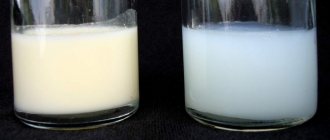Oh horror, water is pouring out of my chest!
Very often, a young mother, while feeding her baby, may hear the phrase: “Look at your milk! Just pure water! Don’t torture the child, give him (her) formula!” Such advice mainly comes from vigilant grandmothers of children who are confident that they are acting with the best intentions.
Indeed, in the first minutes of feeding, a woman can clearly see that the liquid released from the nipples is transparent and colorless, almost watery. Often at this stage, a nursing mother is overcome by a feeling of guilt in front of the child, because the woman mistakenly believes that such food is useless for the baby.
Encouraged by loving grandmothers, a nursing mother often opts for formula. And this is a huge mistake. If you observe the milk immediately at the end of feeding, you can see that its consistency has changed - it has become white, opaque and thick.
Foremilk and hind milk - myth or reality?
In fact, in the female breast there is no magic switch “change foremilk to hindmilk,” nor is there any specific time after which foremilk should be replaced with hindmilk.
The existing misconception regarding the change from “foremilk” to “hind” milk will help to resolve the explanations about how the mammary gland works (thanks to the KellyMom website):
Women's breasts typically produce one type of milk, what is commonly called “hind milk,” which is fatty and rich in nutrients.
There is no clear distinction between “front” and “hind” milk; it changes gradually from the moment milk lets in (of which there are several during each feeding, although most women notice only the first or do not notice them at all).
Since the composition of milk changes during feeding and all babies take different amounts of time to get the required portion of hindmilk, it is very important to allow the baby to nurse as long as he needs, without limiting the time.
During breaks between feedings, milk accumulates in a certain amount in the mother's breast. Fat particles adhere to the walls of the alveoli in the upper part of the breast, where milk is produced, and the low-fat milk ("foremilk") gradually moves down (as fat has accumulated at the top), filling the cavities of the mammary gland, that is, the place from which it flows into the baby's mouth at the very beginning of feeding. This is the very “front” milk that he receives before the first flush.
When the let-down reflex is triggered, the milk is “pushed” down the breast ducts so that the baby can feed. As the breasts empty, fat particles move out of place and are directed down the ducts. Thus, the longer the feeding goes on, the more fatty milk comes out of the breast, because more and more fat particles are forced out.
Imbalance of "fore" and "hind" milk
But why do they sometimes write about the imbalance of “foremilk” and “hindmilk” and related digestive problems in a child? Mothers sometimes complain about excessive gas formation - the baby is “fat”, mothers note his nervousness and green, loose stools with a high acid content.
If a nursing mother has a lot of milk and a good “capacity” of the breast, then between feedings a fairly large amount of milk with a relatively low fat content (the same “front”) may accumulate, and the baby may not receive enough of the necessary fatty milk during feeding, his stomach will be full earlier.
The baby will often ask for the breast due to the discomfort experienced. Feeding will relieve some of the discomfort due to the movement of gases, but not for long. Babies often pass gas or defecate during or immediately after feeding. Unfortunately, very soon the child experiences discomfort again and the cycle repeats again.
To avoid or reduce the risk of this apparent imbalance in milk, allow the baby to finish feeding completely on one breast before offering the other - do not limit the feeding time (for example, “10 minutes on each breast”). It is also not advisable to distract the baby while feeding on the first breast or forcefully transfer it to the second breast.
How to make sure that the baby receives “front” and “hind” milk in the right quantities?
It’s great when a child has the opportunity to receive the entire volume of milk from his mother’s breast. But what should those kids do for whom this is not available? How can mothers who supplement their babies with donor breast milk stop worrying about what kind of milk they are currently feeding their baby - “front” or “hind”?
The most important sign is a cheerful state of health, good digestion and dynamics of the baby’s weight. If everything is in order with these parameters, then asking the question “is it fore or hind milk” is generally pointless.
Most likely, with long-term or large-volume supplementary feeding, you will have to use and mix milk from different breastfeeding mothers. In this case, even if the amount of fat in milk differs markedly for individual mothers, the total mass will result in a kind of “milkshake” - breast milk that is average and balanced in fat composition. It is also important to remember that breast milk can look very different, but it will still be normal breast milk.
When you have seen a lot of different breast milk, you can indirectly judge by its appearance - how thick a layer of cream has separated in it during storage. But here it is important to keep in mind that this layer turns out differently for different mothers, and it happens that the layer is very thin, but in nutritional value this breast milk is in no way inferior to that which consists almost entirely of “cream”. And it happens that the milk layers so thinly that it is impossible to notice with the eye where one layer ends and another begins.
If something still causes concern, you can talk to the milk donor mother and ask when she pumps. Theoretically, increased milk consumption can be observed if a breastfeeding mother expresses milk for donation only at the beginning of feeding her baby. If donor breast milk is expressed between feedings, at the end of feeding, or in parallel with feeding your baby (the baby is attached to one breast, and the other is expressed), then such milk will contain exactly the same amount of “front” and “back” as the mother’s own baby receives – donor during feeding.
In preparation, materials were used from: https://www.mother-2-mother.com/motherconcerns.htm
Translation by Sholpan Nurgalieva for “Milk Mother”
Let's understand the terminology
It is important to understand that women's breasts do not produce two different types of baby food. It’s just that during the feeding process, the baby receives so-called hind and fore milk.
You can understand what breast milk is, front and back, by imagining a glass of cow's milk. Of course, the comparison is not entirely flattering, but the principle of operation is similar. After standing for a while, the drink in the glass will separate into thick and dense “cream” and a translucent light white liquid. Much the same thing happens during the production of human milk.
Another apt analogy is a hot water tap. At first, cold water comes out of the tap, gradually warms up and finally becomes hot. In the same way, the foremilk is gradually replaced by the hind milk.
In the intervals between feeding the baby to the breast, the milk is “divided” into thinner and clearer foremilk and thicker hindmilk. As a rule, the front one has a white-blue tint. It is rich in carbohydrates.
What is hindmilk? Mother's milk is fattier in composition and thicker in consistency than fore milk.
At the beginning of feeding, the baby receives foremilk. Light and quickly digestible, it perfectly quenches the baby’s thirst. After some time, it is replaced by more viscous and fatty hind milk. It is this that gives the child the necessary fats, which means it is necessary for the growth and development of a small person. The change in milk fat content from the beginning of the feeding procedure to the end is a completely natural, natural process. The composition of proteins and lactose remains unchanged when moving from one type to another.
Why does separation occur?
Milk accumulates in the mammary glands until the newborn shows interest in them. It collects in the alveoli, ducts, and milky sinuses. Fat particles stick to microscopic bubbles in the upper part of the breast. And the low-fat nutrient liquid flows down.
The low-fat portion fills the cavities of the mammary gland, first entering the newborn’s mouth. Before the primary flush, foremilk always comes in. As the breast empties, fat particles move from their place, heading through the milk ducts to the nipple. The longer the lactation process goes on, the more fatty liquid comes from the gland. This occurs against the backdrop of increasing displacement of fat particles.
The division into the mother's fore/hind milk is considered conditional. The composition of the nutrient fluid changes with each episode of lactation.
How to feed your baby
Foremilk and hindmilk - how to properly feed the baby so that he is full and receives all the necessary substances? Does baby need a lower fat front drink?
You need to remember the basic rule - the more often the baby is put to the breast, the more uniform nutrition he receives. In this case, there is no special transition between the foremilk and hindmilk; it is uniformly fatty and nutritious. If feeding periods are more rare - once every 2-2.5 hours, fat content will increase as feeding occurs.
The more your baby empties, the more fatty hindmilk he will receive at the end of the feeding.
That is why it is very important to ensure that the baby sucks completely from the breast. Otherwise, hindmilk may simply not reach the baby.
Hind milk and front milk should be well absorbed by the baby. In order for your baby to get the maximum benefit from breastfeeding, you should follow simple recommendations.
Correct application
If the nipple is not latched on correctly, the baby runs the risk of not receiving nutritious hindmilk. It is imperative to master proper attachment in order to begin feeding your baby fully while still in the maternity hospital.
We feed at night
Night feedings. Stimulates milk production, including hind milk. For mothers whose children sleep all night without waking up to feed, milk disappears much faster and more often. Hind milk “lulls” the baby to sleep, after which the baby wants to sleep. If a baby falls asleep with the nipple in his mouth and periodically sucks on it in “sleep mode,” you should not take the breast away from him. Otherwise, he may not get enough hindmilk. A well-fed baby will let go of the breast on its own and continue to sleep.
Mixtures – no solids
Refusal of mixtures. Additional supplementary feeding can negate all the mother’s attempts to establish guard. If it seems that there is not enough milk, you need to offer the breast to your baby more often. It's okay if your baby hangs on your chest for hours. Over time, the saturation process will occur faster. The main thing is not to aggravate the situation by introducing mixtures without medical indications.
One feeding - one breast
Breast change rule. During feeding, the baby should empty strictly one breast, and not both at once. You should not change your breasts for at least two hours. For the next meal, he is offered another, full breast. If the baby is capricious and does not take the nipple, there is no need to insist. The same breast should be offered to him after 15-20 minutes.
And only in some special cases (for example, in case of acute shortage of milk) after the baby has “drank” the first breast, can you immediately give the second one. In this case, we stimulate our body to produce more milk. If the baby has enough nutrition, there is no need to do this.
Don't pump
Refusal to pump. Is it necessary to express foremilk before breastfeeding? Many mothers express foremilk so that the baby can immediately move on to fatty foods. You shouldn't do this. After all, foremilk, rich in carbohydrates, gives the child strength and energy for active movement, growth, and development. It provides the necessary water. It's useful too.
In addition, the mother does not always know how to understand that hind milk is already flowing. A hungry baby will cope with the task better than any breast pump. You only need to express in rare cases, when excess milk threatens with blockage of the mammary glands and mastitis. In this case, you can express all the hind milk with a breast pump and offer it to your little one using a bottle.
Interestingly, some young mothers reflexively shake their breasts before feeding. It is believed that this technique allows the milk to “mix” and become more homogeneous. Naturally, such a procedure must be carried out as carefully as possible, without causing pain or discomfort to the mammary glands.
Foremilk and hindmilk during breastfeeding
Woman's milk is the healthiest form of nutrition for infants. In order for the baby to receive a sufficient amount of vitamins and micronutrients, breastfeeding rules should be followed. Feeding technique is important, since foremilk and hindmilk during breastfeeding have different properties and energy value.
Table of contents
|
What is foremilk and hind milk
A nursing woman's breasts produce a nutritious secretion called milk.
The fluid produced by the mammary gland is heterogeneous in composition. It is divided into fore and hind milk.
The anterior secretion is necessary to quench the baby's thirst. It contains more lactose, but less fat and protein.
The anterior secretion arrives immediately after application to the breast (10-15 minutes), its calorie content is low.
Hind milk is rich in proteins and fats. It contains more calories, vitamins, and micronutrients.
The posterior secretion is located in the deeper parts of the mammary gland.
How to feed your baby correctly
In order for the baby to receive both front and rear breast milk, it is necessary to follow feeding techniques.
This ensures complete, healthy nutrition for the baby.
With sufficient lactation, it is recommended to feed one mammary gland at one feeding.
In this case, the baby sucks out first the anterior and then the posterior secretion.
If the lactation function is insufficient, first one breast is given, and then the other.
In this case, the baby must suck out the first mammary gland completely.
If the child does not have enough of one breast, the second is offered until he is completely full.
If feeding techniques are not followed, a lack of vitamins and other trophic diseases occur.
A baby who is fed only foremilk may develop false lactase deficiency.
The anterior secretion contains a lot of lactose, which the baby’s stomach does not digest well.
Against the background of excess lactose, diarrhea syndrome (foamy stools), dehydration, and colic develop.
Proper attachment is the key to baby health
In order for the baby to receive fore and hind milk, it must be applied correctly to the breast.
The baby is held in his arms so that his tummy is turned towards his mother. This way the sucking will be most effective.
The child must grasp not only the nipple, but also the areola to create maximum vacuum.
In this case, the baby gets not only the anterior secretion, but also the posterior one.
Useful tips for mothers: BASIC FEEDING RULES
If the baby only grasps the nipple, the sucking force is insignificant.
In this way, a child cannot receive hindmilk, rich in microelements and fats.
Against the background of improper application, malnutrition, deficiency of vitamins and micronutrients occurs.
To prevent the development of malnutrition and other conditions, you should teach your baby to grasp the breast correctly.
Feeding mode
The division of milk into hind and front milk occurs only if there is an adequate feeding regime.
The intervals between meals should be at least 2.5-3 hours.
This allows the milk to be produced in the required quantity and divided into different fractions.
If the baby is constantly “hanging on the chest,” the anterior and posterior fractions are mixed.
For this reason, it is recommended to wait at least 2 hours for the fatty secretion located at the base of the gland to ripen.
Feeding at night
Lactation is based on a woman’s hormonal background.
The hormones oxytocin and prolactin regulate lactation function.
Prolactin is responsible for the production of milk by the alveoli of the gland. Oxytocin promotes the movement of milk secretion through the ducts.
Prolactin is a night hormone. It is produced at 4:00-5:00 in the morning in greater concentration than at the rest of the day.
For this reason, night feeding is recommended to stimulate the production of prolactin and maintain lactation.
It is advisable to feed 1-2 times at night. The baby should be put to the breast when waking up.
He is held on the chest until he falls asleep and releases the chest.
This technique allows the baby to reach the fatty posterior secretion.
When the baby is full, he releases the breast on his own and falls soundly asleep for 2-4 hours.
During this time, the nutrient fluid is collected again and divided into 2 types.
You should not wean your baby's breasts at night.
He won’t get enough to eat, will wake up his mother more often, and will not allow milk to form.
All this will lead to nutritional deficiency.
Why is milk like water?
Poor formation of milk secretion is observed in women with hypolactia. This condition is characterized by a decrease in the volume of milk secretion, as well as a decrease in its quality.
Reduced lactation function is most often provoked by diseases of the thyroid gland (hypothyroidism, nodular goiter), as well as diabetes mellitus and other conditions.
With endocrine diseases, the functioning of lactation hormones is disrupted, which leads to the appearance of milk with a blue tint.
But, before contacting a doctor, you need to carefully decant the expected oily discharge.
The anterior fluid is normally clear and runny, the posterior fluid is yellowish-white, thicker and more viscous. It is necessary to first express the anterior secretion, and then the posterior one. If even the last drops of milk secretion are transparent, you need to visit a gynecologist for examination and treatment.
In case of hypogalactia, it is recommended to maintain lactation. Continue to breastfeed the baby at night to stimulate the production of the hormone prolactin.
Lactogonic teas and proper nutrition are prescribed. If the patient has thyroid disease, hormonal medications are indicated.
If you have diabetes, nutritional correction and medications that lower blood sugar are recommended.
Do not use mixtures
The anterior secretion is lighter and more transparent than the hind milk. During pumping, before reaching the deep fraction, mothers get scared.
It seems to them that milk secretion is not nutritious enough for the baby. After this, the mother tries to give the baby formula to compensate for the “poor quality” of her own milk. This should not be done.
Mother's milk contains many vitamins, micronutrients, enzymes, and immunoglobulins.
To properly check the quality of milk before using the formula, you need to express the entire breast to the last drop.
It is recommended to pour the back portions not into a common cup, but into a separate glass. The further portion will be fattier, richer and yellower.
This means that the mother’s milk is of normal concentration, there is nothing to worry about.
Mixtures can only be used as directed by a pediatrician.
Substitutes can be prescribed for:
- lack of lactation;
- poor quality of milk discharge;
- inability to breastfeed for medical reasons (maternal illness requiring the use of medications that negatively affect the baby’s body);
- mother's refusal to breastfeed.
How to maintain lactation function
For good lactation, you should eliminate stress and rest more often.
The mother is recommended to sleep during the day with the baby.
Nighttime feeding can be done in the mother's bed to make getting up at night easier.
After feeding, immediately transfer the baby to a crib.
Mom should sleep at least 8 hours a day. Take daily walks in the fresh air with your baby.
To ensure normal milk secretion production, you need to follow a drinking regime.
A nursing woman should drink at least 2.5-3 liters of water per day.
At night, you should place a glass of water on the table next to your bed.
Dehydration should not be allowed.
The baby must be fed on demand.
If the amount of milk discharge decreases, the frequency of feeding is increased to stimulate the production of hormones.
You need to eat rationally. The menu should include cereals, soups, meat, fish, fruits, and vegetables.
Allergenic foods are excluded from the diet (oranges, tangerines, seafood (shrimp, caviar), chocolate).
You should not drink coffee, eat fried, fatty foods, or canned foods.
Food must be steamed, baked or boiled.
To maintain the health of the baby, it is recommended to know the characteristics of mother's milk.
Be sure to take into account the division of milk secretion into anterior and posterior fractions, since they have different functions.
In order for the baby to receive both portions, you should put him to the breast correctly, follow the feeding schedule, maintain night feedings, and eat right.
Olga Kuznetsova
DOCTOR - PEDIATRIC Education: Siberian State Medical University. Certificate of specialist in the specialty "Pediatrics"
What if the baby is lazy to suck?
There are often cases when a child is too lazy to suck out hind milk, limiting himself only to front milk. The main reason is that the accumulated foremilk is supplied to the baby almost on its own, i.e. flows even with minimal sucking. But in order to suck out the fattier hind milk, the baby needs to work hard, which not every little one likes.
In this situation, it is important for the mother to be patient and follow several recommendations:
Do not change breasts for at least two hours (in some cases it is necessary to set a longer “duty” of one breast - for three hours). If the mother offers her left breast during feeding, you need to “treat” the baby with it until it is completely empty.
Be patient. Often, having tasted the foremilk, the baby no longer strives to get to the hindmilk. In this situation, he can be capricious, fidget, pull on his mother’s nipple, and cry. Mom needs to be persistent and offer the breast until the milk in it completely disappears. This does not mean that the breast should be forced into the baby. It is better to wait out the period of whims by rocking the baby and playing with him. After some time, you need to offer the breast again.
If your baby is too lazy to eat hind milk
Often a newborn is lazy to suck out the posterior nutrient fluid, limiting himself only to the anterior one. This is due to the fact that foremilk flows easily into the baby's mouth without any effort on his part. And in order to suck out the fatter mature one, you need to work hard. More lazy people are born, and fewer hard workers.
If a nursing mother begins to notice this trend, she can take the following measures:
- Do not change the mammary gland for 2-3 hours. Starting with the right/left breast, the baby should suckle until it is completely empty.
- Having drunk a portion of the front liquid, the baby no longer wants to seek the back one. He begins to act up, twist his head, and pull on his nipple. The mother continues to persistently give to the chosen breast until the milk in it completely disappears.
The mother should not force the nipple into the baby's mouth. While the newborn is capricious, he is distracted by games or rocking. The calmed newborn is given breastfeeding again.
A diligent baby, when the breast is completely emptied at the end of feeding, receives a large portion of mature milk.
Milk imbalance
A common occurrence during breastfeeding is an imbalance of foremilk and hindmilk, its symptoms are as follows:
- restlessness while eating;
- the baby's stool is liquid and foamy in consistency;
- bloating, gas;
- frequent regurgitation after eating;
- underweight.
In this case, there is no need to give up breastfeeding.
The best solution is to provide your baby with constant access to the breast and, if possible, refrain from pumping. And also follow all the points of “correct” breastfeeding listed above. Over time, lactation will improve, and digestive difficulties will go away on their own. If the symptoms do not disappear, then they may be caused by lactase deficiency. It occurs due to undigested lactose. Foremilk, which contains no fat, moves very quickly through the digestive tract. As a result, the milk is not completely digested, creating tummy problems. This situation can be corrected. You need to contact your pediatrician, he will prescribe special enzymes and other medications. The introduction of lactose-free mixtures may be required only as a last resort. In most situations you can do without them.
How to determine the imbalance of fore and hind milk
During lactation, an imbalance of foremilk and hindmilk sometimes occurs. This condition is indicated by the following symptoms:
- the baby behaves restlessly while eating;
- the child often spits up after eating;
- baby's stool is liquid and foamy;
- the newborn is capricious from increased flatulence and intestinal colic;
- the child is not gaining weight well.
This phenomenon is associated with the fact that the baby eats a lot of watery milk, but does not get the hind milk. This happens not because of problems with the mother’s nutritional product, but because of the baby’s chaotic attachment to the gland.
If the mammary gland has stopped filling between episodes of breastfeeding, then this is not a reason to panic. This is often associated with the physiological establishment of lactation. The nutritional product begins to be produced when the infant suckles. Liquid will accumulate only during long breaks in breastfeeding.
How to understand that a child has received both types of milk
The optimal indicator that the baby has received plenty of fore and hind milk is the mother’s “empty” breast. A well-fed baby, coming off the breast, usually falls asleep in a sweet dream.
But sometimes a mother, for a number of reasons, is not able to feed on her own. In such cases, some women use donor milk obtained from other breastfeeding mothers. Sometimes a woman feeding her baby with donor “food” wonders whether her baby is receiving enough hind milk.
The appearance of milk is not always an indicator of its fat content. Often, milk that is liquid in consistency turns out to be very satisfying and nutritious.
The main indicator that everything is in order is the baby’s good health, cheerfulness, absence of digestive problems, normal development and weight gain.
What do foremilk and hindmilk mean?
Foremilk and hindmilk are not different types of milk , but 2 terms that describe the nutritional fluid at the beginning/end of a feeding. There is no clear distinction between foremilk and hindmilk. The characteristic changes gradually from the moment of influx of nutrient fluid during the next episode of lactation.
Properties and color of fore and hind milk:
- The anterior one is bluish, translucent, more watery. Rich in lactose (milk sugar), minerals, protein compounds. A portion of foremilk provides the baby with the necessary fluid.
- The back is white or yellowish, thick. It contains higher amounts of fats, fat-soluble enzymes, growth factors and sleep factors.
A nursing woman finds it difficult to determine the fat content of milk by its appearance. Even a dairy product with a liquid consistency can be nutritious and satisfying. When the baby suckles at the breast, he first receives a portion of foremilk, and then gradually the hindmilk with a high fat content comes in. The mature product reaches the baby faster when it is frequently applied to the maternal glands.
What does Dr. Komarovsky say about this?
Let's say right away: the famous children's doctor Evgeny Komarovsky is an opponent of feeding on demand. He believes that uncontrolled and frequent sucking without a clear regimen leads to the child overeating. Hence – digestive problems, excess weight and other troubles. On the other hand, Komarovsky agrees that routine feeding, which was enforced in Soviet times, is a relic of the past.
Komarovsky himself promotes so-called free feeding. The difference with on-demand feeding is that with free feeding it is recommended to breastfeed only when the baby is really hungry and for no more than 20 minutes. If you feed on demand, then you can breastfeed whenever the baby asks: even if he does it not because of hunger, but because of stress or boredom. And you can hold it at the breast as long as the baby wants.
Komarovsky's point of view differs from the position of the Association of Lactation Consultants. On the Internet you can find discussions between the famous doctor and consultants about breastfeeding.
At the same time, a well-known pediatrician admits that when feeding on demand, the risk that milk will disappear is indeed lower than when feeding according to a schedule. But, in his opinion, there are many disadvantages.
As for the terms foremilk and hindmilk, Komarovsky does not recognize them in principle. He says he has never seen them in any medical textbook. At the same time, he agrees that the calorie and fat content of milk increases slightly during feeding.
Every mother wants to give her baby all the best and healthiest things. This also applies to breast milk. Often, in an attempt to provide the baby with hind milk, the mother goes to extremes - she begins to express, introduces formula, etc. But if the child is developing well and gaining weight normally, additional manipulations on the part of the mother are completely unnecessary. Having patience and following the recommendations for establishing lactation, a nursing woman will very soon cope with the first difficulties of breastfeeding.
How to feed
Frequent feeding of the newborn to the breast provides him with the most uniform nutrition. The resulting liquid will be uniformly fatty and nutritious. The newborn will not feel much of a transition from watery to mature. If lactation occurs once every 2-2.5 hours, then the nutrient fluid becomes fatty as the lactation process progresses.
It is important to ensure that the baby sucks completely from the breast. Otherwise, hindmilk may not reach the baby. Both types of nutritional fluid should be well absorbed by the newborn. Natural lactation will be beneficial for the baby if the woman understands all the nuances of this issue.
Correct application
If the nipple is latched on incorrectly, the risk of not receiving hindmilk increases. The mother must ensure that the baby is properly attached to the breast:
- The head and body are located on the same line. The body is pressed against the mother at a right angle.
- The baby's face is turned towards the mammary gland, and the nose is towards the nipple. A position that is comfortable for both is selected.
- The head is thrown back and the mouth is wide open. They bring the baby to the breast, and not vice versa.
- It grabs the nipple, the isola, and partially the surrounding gland tissue with its mouth. Infants who try to suck the tip of the nipple with the tips of their lips remain hungry and also cause pain to the mother.
- The nose is pressed tightly to the mammary gland, but is not recessed into it. There are no extraneous sounds in the process, except for sips. The woman does not experience discomfort or unpleasant sensations.
Even before the maternity hospital, the expectant mother must master proper attachment in order to feed the baby correctly from the first days. If a woman is determined to breastfeed, then she should not give her newborn an artificial formula in the maternity hospital. The bottles are equipped with comfortable nipples with large holes, suitable for lazy children. Breasts quickly feel the difference. They choose bottles, abandoning the natural way of eating.
Night feedings
Stimulation of uniform milk production occurs best with night feedings. If babies sleep peacefully all night, the mother's milk will disappear faster. Sometimes the baby falls asleep with the nipple in his mouth and periodically sucks on it even while dozing. There is no need to take the breast away from him - this way he will not get enough of the posterior nutrient fluid.
The age and individual characteristics of children affect the frequency of feedings. Breastfeeding requires frequent nighttime lactation. Closer to 6 months, they sleep longer at night. In older children, the need for sucking shifts to the second half of the night, closer to the morning.
A well-fed child releases the gland on his own, continuing to sleep peacefully.
Breast change
When eating, the baby must empty 1 gland. It is not changed for at least 2 hours. And with a new episode of feeding, he will be offered a second filled gland. Children are sometimes capricious and refuse to take the nipple. Insisting in this case is inappropriate. After 15-20 minutes, when the baby calms down, he is given the same gland again.
In case of acute lack of nutritional fluid, the baby immediately moves to the second after the first mammary gland. This will help the woman stimulate her body to produce more nutrient fluid. If the baby is fully saturated with one gland, this should not be done.
The main reasons for deterioration of lactation:
- large gaps between feedings of the baby;
- irregular breastfeeding;
- the baby is weakened, sucks sluggishly;
- a lactating woman experiences stress;
- inflammatory diseases of the mammary gland.
Lactation stabilizes when unfavorable factors are eliminated. If a nursing mother has experienced a great shock or pain, then the following will help her restore the flow of milk: special breathing exercises, calm deep breathing, taking a warm bath with the baby, doing something we love, or a delicious lunch.
Pumping
Many nursing mothers express foremilk in order to ensure that the newborn quickly transitions to a portion of mature food. It is a mistake to use such tactics. Foremilk is rich in fast carbohydrates. Gives the baby the strength and energy necessary for growth, development, and motor activity. It also normalizes water balance.
When using a breast pump, a mother cannot always distinguish between fore and hind milk. A hungry baby will cope with the task better than any device. Pumping is resorted to when there is a threat of blockage of the ducts and the development of mastitis. For medical reasons, the woman expresses all the milk and feeds it to the baby from a bottle.
Before feeding, some mothers shake their breasts. This is due to the common belief that such manipulation allows the milk to become more homogeneous. GW specialists consider this unnecessary. But if a woman performs such a manipulation, then it is important to do this carefully, without pain or discomfort to the glands.
Duration of feeding
There are no clear boundaries regarding the duration of feeding. It depends on the individual abilities and needs of the baby. A healthy newborn breastfeeds for at least 30 minutes. This indicator is individual for each baby.
Active workers are not lazy to suck, so they quickly fill up and release the mammary gland. Other babies suckle slowly, falling asleep in the process. But they are activated if you try to remove the nipple. To resume active feeding, slightly remove the nipple or touch it on the cheek.
Typically, at the beginning of lactation, the baby is fed up to 10 times a day. As the child grows, the feeding schedule is reduced to 7-8 times per day.
Feeding mode
Pediatricians and neonatologists continue to debate about feeding regimens. Some insist that a schedule is mandatory. Others advise giving the newborn the breast when he asks for it. But in case of any concern, it is inappropriate to impose it. Whims can be associated with temperature discomfort, a dirty diaper, or a desire to attract attention.
The interval between lactations can range from a quarter of an hour to 2-3 hours. Regularity in requirements is usually established by 2-3 months. A nursing woman easily recognizes this and successfully adapts to it.
Common mistakes
During breastfeeding, women often make similar mistakes:
- Some wash the mammary glands (the norm is 1-2 times a day). With frequent hygiene procedures, the protective lubricant is washed off, protecting against the proliferation of pathogenic microorganisms.
- Hold your breasts with your hands while feeding. Such actions provoke lactostasis, which significantly impairs further full lactation.
- During feeding, they are distracted by TV, computer, mobile phone or other extraneous stimuli. This breaks the bond between mother and baby.
- They refuse breastfeeding and switch to artificial formulas if cracked nipples or a cold appear. For painless feeding, it is correct to use special silicone nipple covers. The baby will not catch a cold from the mother if she wears a protective mask.
Young mothers make other mistakes during lactation. A nursing woman should discuss unclear issues with a gynecologist or pediatrician. By being patient and following the advice of breastfeeding consultants, the mother will cope with the first difficulties that accompany the feeding process.
Forward and hind breast milk are equally important for the growth and development of the baby. With proper lactation, the baby gains weight well, is less capricious, and does not experience an unjustified feeling of hunger. Breastfeeding not only makes children healthier, but also creates a close relationship with the mother.
Foremilk and hindmilk: what is the difference?
Many breastfeeding women are faced with a situation where a translucent liquid is released from the breast instead of the usual white milk. It is called foremilk and, contrary to popular belief, it does not at all signal that a woman has any problems.
In the intervals between feedings, the milk in the breast is divided into two parts: the more liquid is concentrated at the exit to the ducts, and the fatty and thick is deposited on the walls of the cell that secretes milk. But this does not mean that the mammary glands produce two types of milk - nature simply arranged everything so that the child can quench both thirst and hunger in one feeding. So the baby first receives foremilk, which has a pale tint - it is rich in carbohydrates and quenches thirst. The baby is then fed hindmilk, which is rich in fats needed for growth.
Since milk changes depending on the baby’s needs, the baby receives nutrition of different consistency. But if you put your baby to the breast more often, the milk will become more homogeneous. When feeding, it is important to ensure that the little one empties the breast completely, otherwise he may not drink hind milk and will quickly want to eat. During feeding, it is better to give the baby only one breast, and not both at once. The exception is when a woman has a lack of milk.











